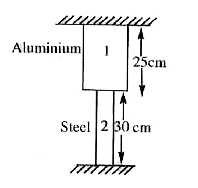Two bars are unstressed and have lengths of 25 cm and 30 cm at 20∘C as shown in Figure. Bar(1) is of aluminium and bar(2) is of steel. The cross-sectional areas of the bars are 20 cm2 for aluminium and 10 cm2 for steel. Assuming that the top and bottom supports are rigid, compute the stress in each member when the temperature is 70∘ C.
Take Ya=0.70×105N/mm2.Ys=2.1×105N/mm2.
αa=24×10−6/∘Candα2=12×10−6/∘C

Given Data :
Length of Aluminium, La=25 cm = 250 mm
Length of steel , Ls = 30 cm = 300 mm
Cross - sectional area of aluminium
As=20cm2=2000mm2 .
Cross - sectional area of steel,
As=10cm2=1000mm2.Ya=0.7×105N/mm2
Ys=2.1×105N/mm2
αa=24×10−6/∘Candαs=12×10−6/∘C
Due to rise in temperature, both bars will tend to increase in length. As the supports are rigid, both of them will be under compression, but the total length will remain unchanged. Hence, contraction of the two bars due to compressive stress = Elongation of the two bars due to rise in temperature
Let simgas= compressive stress in steel
simgaa = compressive stress in aluminium
T = Rise in temperature = 70 - 20 =50∘ C
Contraction of the two bars due to compressive stress
= σs2.1×105×300+σa0.7×105×250..... (1)
Elongation of the two bars to rise of temperature αs.T.Ls+αa.T.La.
=12×10−6×50×300+24×10−6×50×250
= 10−6[48×104] = 0.48 mm .......... (2)
Equating equations (1) and (2) , we get
σs2.1×105×300+σa0.7×105×250
142.86Ss+357Sa=48000
Also, force in steel = force in aluminium
singas×As σa×Aa σs×1000=σs×2000
σs=2σa .......... (3)
From equation (3) substituting the value of σs=2σa,
we get 142.86×2σa+357σa=48,000
αa = 74.68 N/mm2 Ans.
σs = 149.36 N/mm2 Ans.
Similar Questions
A steel bar of cross sectional area 1cm2 and 50cm long at 300C fits into the space between two fixed supports.. If the bar s now heated to 2800C, what force will it exert against the supports ? (⋅ for steel =11×106/0C and Young's modulus for steel =2×1011N/m2)
View SolutionDetermine the elongation of the steel bar 1m long and 1.5cm2 cross-sectional area when subjected to a pull of 1.5×104N.
(TakeY=2.0×1011N/m2).View Solution
Knowledge Check
- Question 1 - Select One
Two bars are untressed and have lengths of 25cm and 30cm at 20∘C as shown in Figure. Bar(1) is of aluminium and bar (2) is of steel. The croos-sectional area of bars are 20cm2 for aluminium and 10cm2 for steel. Assuming that the top and bottom supports are rigid, stress in Nmm2 when the temperature is 700C. (Nearly)
(Ya=0.70×105N/mm2Ys=2.1×105N/mm2.αa=24×10−6/0C and αs=12.×10−6/0C)
_E01_126_Q01.png) A75,150B25,50C50,100D100,200
A75,150B25,50C50,100D100,200 - Question 2 - Select One
The magnetization of a bar magnet of length 5 cm,cross-sectional area 2cm2 and magnetic moment 1 Am2 is
A1×105AmB2×105AmC3×105AmD4×105Am - Question 3 - Select One
What is the intensity of magnetisation of a bar magnet of length 4 cm cross sectional area 2.5 cm2 and magnetic moment 2 Am2 ?
A105 A/mB2×105 A/mC3×105 A/mD0.5×105 A/m
Determine the elongation of the steel bar 1m long and 1.5cm2 cross-sectional area when subjected to a pull of 1.5×104N.
(Take Y=2.0×1011N/m2).View SolutionDetermine the elongation of the steel bar 1m long and 1.5cm2 cross-sectional area when subjected to a pull of 1.5×104N.
(TakeY=2.0×1011N/m2).View SolutionA heavy brass bar has projections at its ends as shown in the figure. Two find steel wires, fastened between the projections, are just taut (zero tension) when the whole systeam is at 00C. What is the tensile stress in the steel wires when the temperature of the systeam is raised to 3000C?
Given that
αbrass=20×10−6∘C−1
αsteel=12×10−6∘C−1Ysteel=2×1011Nm−2
_E01_077_Q01.png) View Solution
View SolutionFind the total elongation of the bar, if the bar is subjected to axical froces as shown in figure . The cross-section area of bar is 10cm2 .
[TakeE=8×102dyne/cm2]
 View Solution
View SolutionA bar mangnet has length 3 cm cross sectional area 2 cm2 and magnetic moment 3 Am2 the intensity of magnetisation of the bar magnet is
View Solution
